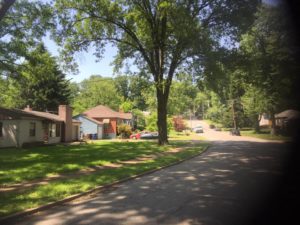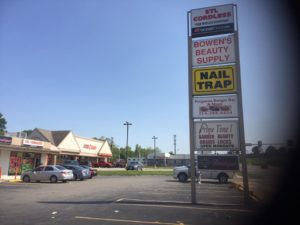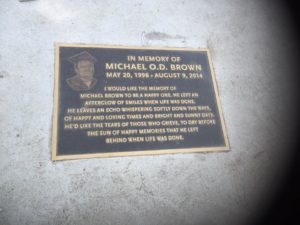
By Sudip Bhattacharya
AsAmNews Staff Writer
Last Friday, I took a trip to Ferguson, Missouri. I plan to incorporate what happened there into my research and activism. I didn’t know what to expect, since I am an outsider and one with many privileges. Although as a journalist I’ve lived and worked in communities very different from my own upbringing, Ferguson represented something unique, a place pulsing with memory and recent history, someplace where one can learn a lot about oneself and better yet, of the US as a whole.
Again, whenever I’ve done assignments for work, in areas that experience disadvantages I’ll never know or truly understand, the main thing I do is try and talk to as many people I can while also exploring on my own. Essentially,I do it to soak in the environment, and therefore, to know it’s landscape like I would my own neighborhood.
I stayed in St. Louis and spent a night and two days in Ferguson, and quickly learned how small it is. I knew that Ferguson is a suburb but was surprised to see that the main avenue where the unrest had taken place after Wilson’s acquittal was literally just two blocks, with strip malls and convenience stores. It would take me two minutes to drive through.
Most of the mom and pop businesses are operating again, with customers flowing in and out, buying snacks and even groceries. Some purchased lottery tickets as well.
LATEST STORIES
There isn’t much, however, in terms of actual options for healthy food, which isn’t surprising. There are shopping malls but accessible for those with card. For example, there is a rather large shopping plaza in the suburb next to Ferguson, which includes a Target. For someone from Ferguson, who doesn’t have transportation, getting there isn’t necessarily an issue. The problem is apparent when one does find what they need, such as milk, eggs, cereal and other basics for the week. How can a less well-off person from Ferguson be able to carry all those items back to their home? It’s impossible to do so, especially when the weather is either freezing or as the summer approaches, scorching. You are tied to the stores nearby, which means relying on a worse diet, and less nutrition. This leads into lack of focus at work or at school, and that too boils over into job and career prospects and life expectations.
So, yes, Ferguson is economically disadvantaged as compared to other parts of St. Louis county. In fact, Ferguson is just one of many suburbs north of the city of St. Louis that suffers economically. Pretty much the northern part of the city as well as the suburbs just mentioned are predominantly Black as well.
Even within Ferguson, there is economic and racial segregation that matches what I’d seen in other cities like Chicago and even St. Louis. For instance, the avenue where the unrest took place is located in the part of town where most of the working-poor and working-class Black Americans live. The other parts of Ferguson that was very similar to places in New Jersey, with brightly green lawns and pristine houses, with cars on the driveway and kids playing and riding their bikes while parents watched and talked, was on the opposite end of the avenue, behind the McDonalds, as if trying to stay hidden among the trees and symbols of suburbia. There were even gates separating communities from one another. City Hall, the Ferguson Police Department, and the main library were located around those neighborhoods. Most of the White Americans lived there, along with some Black families too.
I was able to attend a church service, interviewed it’s pastor, had discussions with those in the community, such as two women working at a local resource center on the main avenue. Many Ferguson residents, according to insights gathered by those working and living in the community, do not understand how to access basic resources, such as utility services, and for those who are poor, distrust the government and all institutions because of their personal experiences with the police of course and their own knowledge as Black Americans (of all classes) that in America, you can vote for change but those already in power (mostly Whites) can maintain their superiority somehow. This is why Black Americans and White allies do not vote or participate even though they are in the majority, while the White minority still manages to control most resources and access to them.
Ultimately, Black residents of Ferguson are still reeling, not just from the recent unrest, but from decades of oppression and frustration. A person I was also able to speak to was a young woman from the same graduating class as Michael Brown. She took part in the initial protests that got tear-gassed and clearly exhibited trauma from her experiences. She came back to her neighborhood to help people, even though there is apprehension etched in her face.
I did find the plaque commemorating Michael Brown. It’s in the sidewalk in the Canfield apartments where he was shot and killed. The apartment complex itself is very serene and seemingly deserted, as if people rushed out as quickly as they could, as far away from the pain.
When I found the plaque, I actually didn’t feel sadness. Anger filled me instead. And I’m not sure exactly why. Maybe it’s because there weren’t any cameras anymore. That the national spotlight has dimmed, that organizations I thought would be here to help weren’t. That the people of Ferguson were essentially abandoned.
The young woman who took part in protests did give me hope that things will change. And speaking with people there, those who were receptive to opening up, revealed how people, in spite of the sorrow and hurt, have such a high propensity to hold on to what makes us human, to go against everything and be rebellious in our own small ways, such as going to work, buying groceries, spending time with the family. I saw people who played outside with their kids, who mowed lawns, who sat and stared up at the sky.
They were there, soaking all of it in.
AsAmNews is an all-volunteer effort of dedicated staff and interns. You can show your support by liking our Facebook page at www.facebook.com/asamnews, following us on Twitter, sharing our stories, interning or joining our staff.







